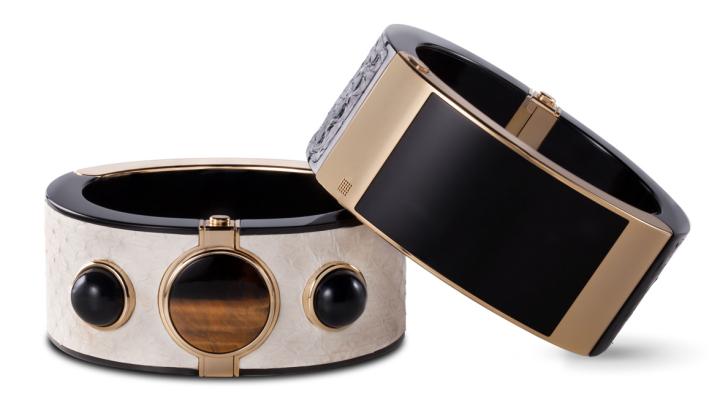Intel Launches MICA Wearable Device
Famous microprocessor company Intel launched its first wrist wearable device, the MICA, at a media event on Monday.
The MICA, which is short for “My Intelligent Companion Accessory,” is a wristband device that features a 1.6 inch LED screen and is stained with an 18k gold coating. The device offers two days of battery life and uses microUSB as its charging and information transfer interface.
Unlike other wearables, the MICA does not need a smartphone to operate. Because it is completely independent from smartphones, MICA has a unique phone number, separate from that of a smartphone. Intel has targeted this device towards women.
According to Intel’s website, “My Intelligent Communications Accessory (MICA), a collaboration between Opening Ceremony and Intel, celebrates what can happen when beauty meets intelligence. [It is m]eticulously designed for the stylish, connected woman and crafted from premium finishes.”
The MICA comes in many different options and finishes, including a black water snake skin variation with pearls from China and lapis stones from Madagascar, or a white water snake skin with tiger’s eye from South Africa and obsidian from Russia.
Apart from an emphasis on notifications based on text messages, email, Facebook messages, and Google contacts, the MICA also has integrated Global Positioning System (GPS) technology which allows for location based notifications through Yelp.
Some students think the device can be useful for notifications and other common features normally accessed on a smartphone.
Other wearable devices in the industry include fitness trackers, such as Jawbone’s Up and FitBit’s Flex, which are specifically designed to monitor users’ exercise levels and diets. Another device, the Nod, is a “smart ring” that allows users to control their laptops and smartphones remotely.
Many students appreciate the novel concepts and capabilities wearable devices bring.
“I think wearable devices are really cool for very niche items like tracking vitals while exercising,” Zabin Bashar (12) said. “ Otherwise, it seems to make more sense just to pull out a smartphone.”

Vedant Thyagaraj is the Science & Technology Editor for Harker Aquila. He is currently a senior and has been on staff for the past three years. Vedant...

Vineet Kosaraju (12) is the STEM Editor for both Harker Aquila and Winged Post. He is a senior and has been part of the journalism program for the past...


















![“[Building nerf blasters] became this outlet of creativity for me that hasn't been matched by anything else. The process [of] making a build complete to your desire is such a painstakingly difficult process, but I've had to learn from [the skills needed from] soldering to proper painting. There's so many different options for everything, if you think about it, it exists. The best part is [that] if it doesn't exist, you can build it yourself," Ishaan Parate said.](https://harkeraquila.com/wp-content/uploads/2022/08/DSC_8149-900x604.jpg)




![“When I came into high school, I was ready to be a follower. But DECA was a game changer for me. It helped me overcome my fear of public speaking, and it's played such a major role in who I've become today. To be able to successfully lead a chapter of 150 students, an officer team and be one of the upperclassmen I once really admired is something I'm [really] proud of,” Anvitha Tummala ('21) said.](https://harkeraquila.com/wp-content/uploads/2021/07/Screen-Shot-2021-07-25-at-9.50.05-AM-900x594.png)







![“I think getting up in the morning and having a sense of purpose [is exciting]. I think without a certain amount of drive, life is kind of obsolete and mundane, and I think having that every single day is what makes each day unique and kind of makes life exciting,” Neymika Jain (12) said.](https://harkeraquila.com/wp-content/uploads/2017/06/Screen-Shot-2017-06-03-at-4.54.16-PM.png)








![“My slogan is ‘slow feet, don’t eat, and I’m hungry.’ You need to run fast to get where you are–you aren't going to get those championships if you aren't fast,” Angel Cervantes (12) said. “I want to do well in school on my tests and in track and win championships for my team. I live by that, [and] I can do that anywhere: in the classroom or on the field.”](https://harkeraquila.com/wp-content/uploads/2018/06/DSC5146-900x601.jpg)
![“[Volleyball has] taught me how to fall correctly, and another thing it taught is that you don’t have to be the best at something to be good at it. If you just hit the ball in a smart way, then it still scores points and you’re good at it. You could be a background player and still make a much bigger impact on the team than you would think,” Anya Gert (’20) said.](https://harkeraquila.com/wp-content/uploads/2020/06/AnnaGert_JinTuan_HoHPhotoEdited-600x900.jpeg)

![“I'm not nearly there yet, but [my confidence has] definitely been getting better since I was pretty shy and timid coming into Harker my freshman year. I know that there's a lot of people that are really confident in what they do, and I really admire them. Everyone's so driven and that has really pushed me to kind of try to find my own place in high school and be more confident,” Alyssa Huang (’20) said.](https://harkeraquila.com/wp-content/uploads/2020/06/AlyssaHuang_EmilyChen_HoHPhoto-900x749.jpeg)



